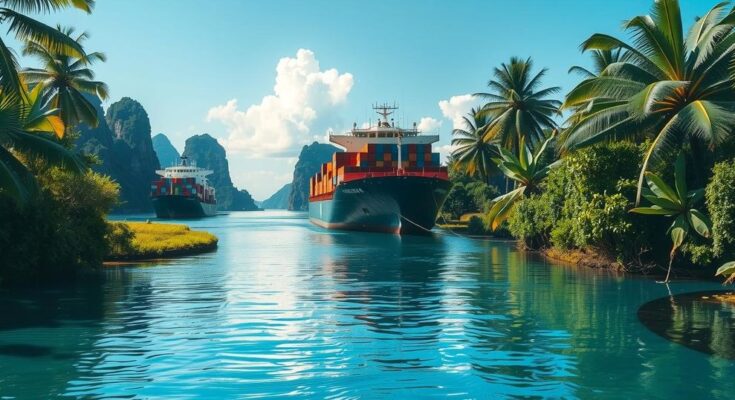The Panama Canal is crucial for global shipping but faces operational challenges due to changing weather patterns and climate variability. Recent years have seen reduced traffic due to water scarcity and operational restrictions, particularly during El Niño events. Ongoing research aims to enhance resilience against future disruptions, while optimism exists for improved conditions as water levels rise in Gatun Lake.
The Panama Canal, an essential global shipping route since 1914, connects the Pacific Ocean with the Caribbean Sea, facilitating the transport of goods worldwide. Its significance has surged into public discourse, particularly with recent comments from prominent officials advocating for U.S. ownership. However, the operation of the canal faces increasing disruptions due to variability in rainfall patterns, raising concern about future shipping stability amidst climate change implications.
The canal operates by utilizing a series of locks that lift and lower ships, allowing for an elevation change of approximately 25 meters. This method significantly conserves time and fuel for vessels, which would otherwise navigate around South America. The canal handles around five percent of global shipping traffic, underscoring its pivotal role in international trade logistics, as noted by industry experts.
Gatun Lake, a critical reservoir for the canal, requires adequate precipitation to remain navigable for large vessels. Over the past three decades, increased dryness has been observed during specific water years, impacting operations. The Panama Canal Authority has responded by restricting traffic and reducing vessel drafts, leading to delays and longer queues for ships, thereby affecting global supply chains.
Research highlights the correlation between recent water-scarce years and El Niño events, which influence rainfall in Panama. While the occurrence of such weather patterns is long-established, there is no definitive evidence linking these changes to climate change per se. However, scientists have documented a rising intensity of storms, foreseeing more frequent extreme weather events that could further challenge canal operations in the future.
Excessive rainfall also poses risks, illustrated by severe flooding incidents that led to the canal’s closure in 2010. Maintaining the earthen dam integrity of Gatun Lake is crucial. Ongoing studies, such as the Agua Salud Project, aim to enhance understanding of the watershed’s hydrology to prepare for extreme conditions and ensure reliable water levels for shipping.
Despite recent challenges, there is optimism for 2025 as Gatun Lake boasts its highest water levels in five years. As the canal adapts to these fluctuating climate conditions, proactive measures will be vital in mitigating future disruptions.
The operational integrity of the Panama Canal is increasingly vulnerable to climate change and variable weather patterns. The current state of water levels in Gatun Lake provides a glimmer of hope for improved shipping conditions in the near future. Ongoing research and projects are essential for understanding and managing the watershed’s hydrology, thus ensuring the canal’s functionality and global trade continuity moving forward.
Original Source: eos.org




